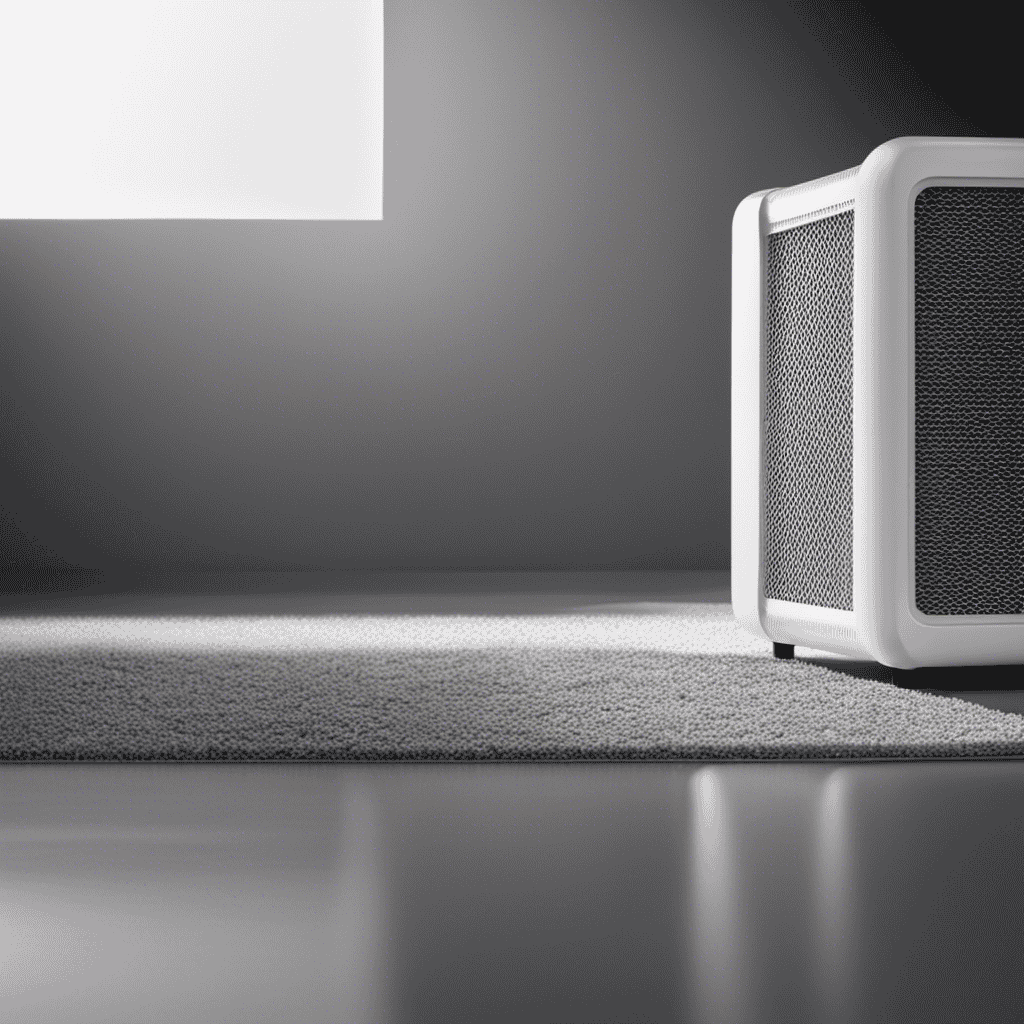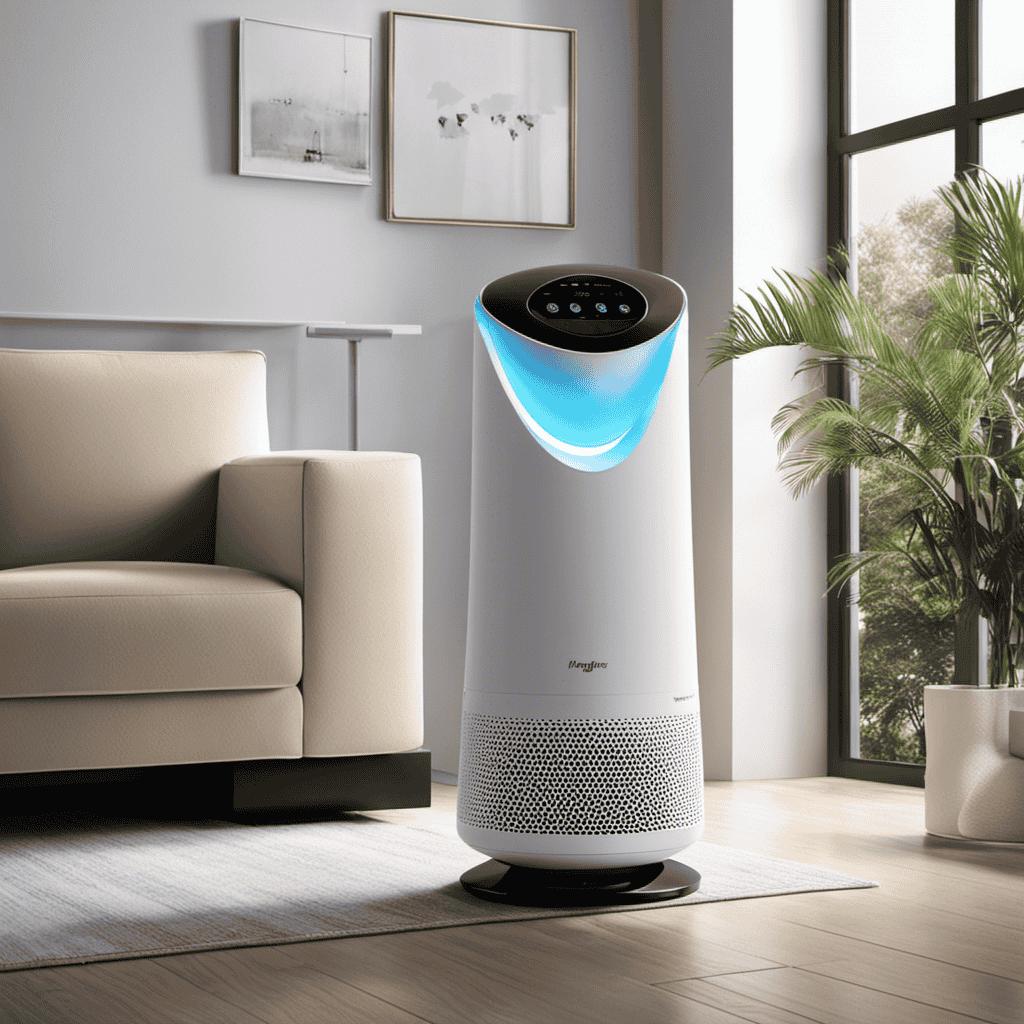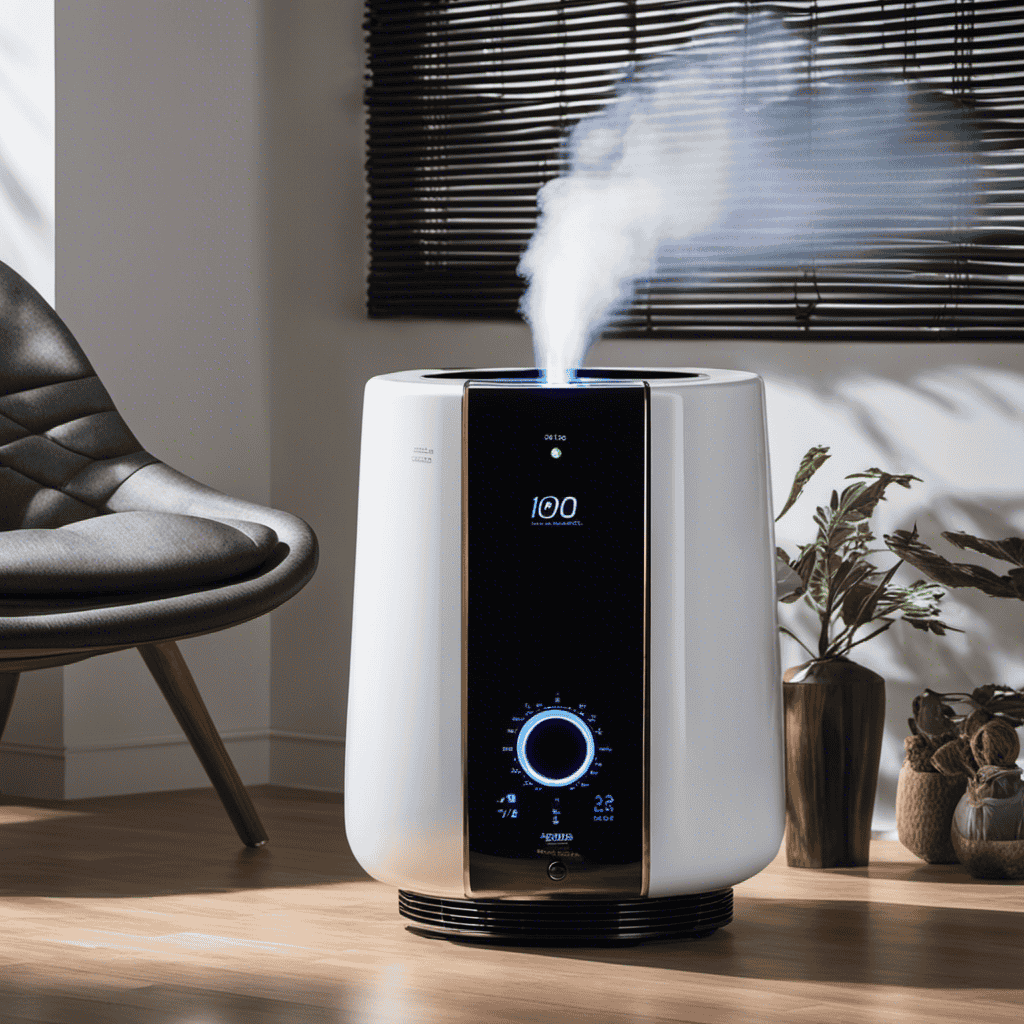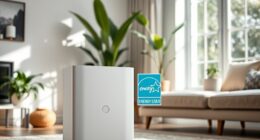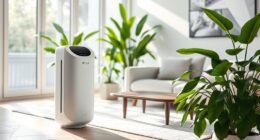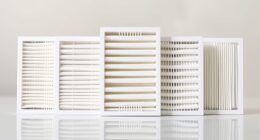Being the owner of an air purifier, I frequently ponder, “How frequently should I replace my air purifier filter?” This is a common question that many people have, and the response is essential for ensuring clean and healthy indoor air.
In this article, I will provide you with expert recommendations and essential information about the lifespan of air purifier filters, signs of replacement, and common mistakes to avoid.
So, let’s dive in and make sure we’re breathing in the freshest air possible.
Key Takeaways
- Regularly changing air purifier filters is important for improving air quality and reducing the risk of respiratory issues and allergies.
- The frequency of filter changes depends on factors such as air quality, usage patterns, filter type, and size.
- Signs that indicate the need for filter replacement include decreased air flow, visible dirt or debris on the filter, and unpleasant odors in the air.
- Neglecting to change filters can lead to reduced effectiveness in capturing airborne particles, increased energy consumption, and a shorter filter lifespan.
Benefits of Regularly Changing Your Air Purifier Filter
Regularly changing your air purifier filter can help improve air quality in your home. By regularly replacing the filter, you ensure that it is able to effectively capture and remove airborne pollutants, such as dust, pollen, pet dander, and mold spores.
This not only helps to keep the air in your home clean and fresh, but it also reduces the risk of respiratory issues and allergies. One of the key benefits of using HEPA filters is their high efficiency in trapping even the smallest particles. These filters are designed to remove up to 99.97% of airborne contaminants that are as small as 0.3 microns in size.
To maximize filter efficiency, it is important to follow the manufacturer’s recommendations on how often to change the filter. Additionally, regularly cleaning and maintaining your air purifier can also help improve its performance and prolong the lifespan of the filter.
Factors That Determine Filter Change Frequency
Typically, factors like air quality and usage patterns affect how frequently you’ll need to swap out your air purifier’s filter. Maintaining your air purifier filter is essential for optimal air quality improvement in your home. Here are the key factors that determine the frequency of filter maintenance:
- Air Quality: If you live in an area with high levels of air pollution or have pets, you may need to change your filter more often.
- Usage Patterns: The more frequently you use your air purifier, the more often you’ll need to replace the filter.
- Filter Type: Different filter types have varying lifespans, so it’s important to follow the manufacturer’s recommendations.
- Filter Size: Larger filters generally have longer lifespans and can handle more particles, reducing the need for frequent replacements.
- Filter Maintenance: Regularly cleaning and maintaining your filter can extend its lifespan and improve its effectiveness.
By understanding these factors, you can ensure that your air purifier is operating at its best.
Now, let’s explore the signs that indicate your air purifier filter needs to be replaced.
Signs That Your Air Purifier Filter Needs to Be Replaced
If you notice a decrease in air quality or an increase in allergies, it’s time to replace your air purifier filter. Regular maintenance and cleaning of air purifier filters are essential for optimal performance and to ensure clean and healthy air in your home. Dust, pet dander, pollen, and other airborne particles accumulate on the filter over time, reducing its effectiveness. Cleaning the filter according to the manufacturer’s instructions can help prolong its lifespan, but eventually, it will need to be replaced. Here are some signs that indicate it’s time for a new filter:
| Signs to Look For |
|---|
| Decreased air flow |
| Visible dirt or debris on the filter |
| Unpleasant odors or smells in the air |
Regularly replacing your air purifier filter is crucial for maintaining clean indoor air quality. It not only improves the performance of the air purifier but also helps reduce allergies and respiratory issues caused by airborne pollutants.
Understanding the Lifespan of Air Purifier Filters
When it comes to air purifier filters, one of the key factors to consider is the frequency of filter replacement. Understanding how often you should replace your air purifier filter is crucial in maintaining its effectiveness and ensuring clean air in your space.
In addition to replacement frequency, there are also various ways to extend the lifespan of your filter, which can save you time and money in the long run.
Filter Replacement Frequency
The recommended frequency for changing your air purifier filter is every 3 to 6 months. Regular filter replacement is crucial to maintain the effectiveness of your air purifier and ensure the benefits of clean air in your home.
Here are some key points to consider:
-
Clean air: Changing your air purifier filter regularly helps to ensure that the air you breathe is free from pollutants, allergens, and contaminants.
-
Improved health: Clean air promotes better respiratory health and can reduce symptoms of allergies, asthma, and other respiratory conditions.
-
Energy efficiency: Dirty filters can restrict airflow, causing your air purifier to work harder and consume more energy.
-
Filter lifespan: Neglecting to change your filter can significantly reduce its lifespan, resulting in more frequent replacements and increased costs.
-
Decreased effectiveness: As filters become clogged with dirt and debris, they lose their ability to effectively capture and remove airborne particles.
By understanding the benefits of clean air and the impact of dirty filters, you can prioritize regular filter replacement to maintain optimal air quality in your home.
Now, let’s explore some strategies for extending the lifespan of your air purifier filter.
Extending Filter Lifespan
To extend the lifespan of your air purifier filter, you can try implementing a regular cleaning routine. Cleaning the filter regularly helps remove trapped particles and prevents them from clogging the filter, which can reduce its effectiveness. The frequency of cleaning depends on the type of air purifier and the environment it is being used in. It is recommended to check the manufacturer’s instructions for specific guidance on how often to clean the filter.
Typically, cleaning the filter every two to three months is a good starting point. However, if you live in an area with high pollution levels or have pets, you may need to clean it more frequently. Regularly cleaning your air purifier filter will not only extend its lifespan but also ensure that it continues to operate at peak efficiency, providing you with cleaner and healthier air to breathe.
Common Mistakes to Avoid When Changing Air Purifier Filters
When it comes to changing air purifier filters, there are a few common mistakes that people often make.
One key point to avoid is improper filter installation, which can lead to reduced effectiveness and even damage to the unit.
Another important consideration is choosing the correct filter type for your specific needs, as using the wrong filter can result in poor air quality and wasted money.
Proper Filter Installation
Installing the filter correctly ensures optimal performance of your air purifier. Here are some key steps to follow for proper filter installation:
-
Carefully remove the old filter from the air purifier, taking note of any specific instructions or arrows indicating the correct orientation.
-
Clean the area where the filter sits, removing any dust or debris that may have accumulated.
-
Place the new filter into the air purifier, making sure it is properly aligned and securely seated.
-
Double-check that the filter is installed in the correct direction, with the airflow arrow pointing towards the air purifier.
-
Close the filter access panel securely, ensuring a tight seal.
Taking the time to properly install your air purifier filter is essential for maintaining its effectiveness. Regular filter maintenance, including proper filter cleaning, will help prolong the life of your air purifier and ensure it continues to provide clean, fresh air for your home.
Choosing Correct Filter Type
Make sure you select the correct filter type for your air purifier to ensure optimal performance and clean, fresh air in your home.
When it comes to choosing the right filter, two important factors to consider are the filter size and the filter material.
The filter size should match the dimensions of your air purifier to ensure a proper fit. Using an ill-fitting filter can result in air leakage and reduced efficiency.
Additionally, the filter material plays a crucial role in capturing and trapping particles in the air. Look for filters with high-quality materials like HEPA (High Efficiency Particulate Air) filters, which are designed to remove 99.97% of airborne particles as small as 0.3 microns.
By selecting the correct filter type, you can ensure that your air purifier effectively removes pollutants and allergens from your indoor air.
Now, let’s discuss how often you should change your air purifier filter for allergies.
How Often Should I Change My Air Purifier Filter for Allergies
It’s important to regularly replace your air purifier filter to effectively combat allergies. Dust, pollen, pet dander, and other airborne particles can accumulate on the filter over time, reducing its efficiency and potentially triggering allergy symptoms.
To ensure the best performance and maintain a healthy indoor environment, follow these filter maintenance tips:
-
Check the manufacturer’s recommendations: Different air purifiers have varying filter replacement schedules, so consult the user manual or product specifications for guidance.
-
Monitor air quality: If you notice an increase in allergy symptoms or a decline in air purification effectiveness, it may be time to change the filter.
-
Consider the environment: High levels of pollutants, such as in homes with smokers or in areas with high outdoor pollution, may require more frequent filter changes.
-
Use a HEPA filter: High-Efficiency Particulate Air (HEPA) filters are highly effective at capturing allergens, so choosing an air purifier with this type of filter can greatly improve allergy relief.
-
Keep spare filters on hand: Having replacement filters readily available ensures you can change them promptly when needed, maintaining optimal air quality.
Tips for Extending the Life of Your Air Purifier Filter
When it comes to maintaining the optimal performance of your air purifier filter, there are a few key techniques that I highly recommend.
First and foremost, regular cleaning of the filter is essential in order to remove accumulated dust and debris.
Additionally, it is important to avoid placing the air purifier in areas where it can be exposed to excessive moisture or heat, as this can significantly reduce the lifespan of the filter.
Proper Maintenance Techniques
Regularly cleaning your air purifier filter is essential for proper maintenance. Neglecting to clean the filter can result in reduced efficiency and compromised air quality. Here are some cleaning techniques to ensure your air purifier filter functions optimally:
-
Vacuuming: Use a soft brush attachment to gently remove dust and debris from the surface of the filter.
-
Rinsing: If your filter is washable, carefully rinse it under running water to remove accumulated dirt.
-
Drying: Allow the filter to air dry completely before reinstalling it in the air purifier.
-
Blowing: Use compressed air or a hairdryer on a cool setting to blow away dust from hard-to-reach areas.
-
Replacement: If your filter is not washable or is severely damaged, it’s important to replace it with a new one according to the manufacturer’s instructions.
Prolonging Filter Lifespan
Now that we’ve covered proper maintenance techniques for air purifier filters, let’s discuss some tips for extending their lifespan.
By following these filter maintenance techniques, you can ensure that your air purifier remains effective for a longer period of time.
Firstly, regularly vacuuming the surrounding area and keeping it free from dust and debris will prevent excessive buildup on the filter. Additionally, using a pre-filter can help capture larger particles, reducing the workload on the main filter.
Another way to prolong your filter’s lifespan is by using your air purifier on the appropriate fan speed setting. Running it on high constantly can cause the filter to clog up more quickly. Adjusting the fan speed based on the air quality in your home will help maintain optimal performance.
Lastly, regularly checking and replacing the filter when necessary is crucial. Most filters need to be replaced every 6-12 months, but this can vary depending on factors such as the air quality in your area and the usage of your air purifier.
The Importance of Proper Maintenance for Air Purifier Filters
Proper maintenance is crucial for ensuring the effectiveness of air purifier filters. Regular cleaning and filter replacement are necessary to maintain air quality and reap the benefits of clean air.
Here are five important steps to maintain air purifier filters:
-
Clean the pre-filter: This captures larger particles and should be cleaned or replaced every 1-3 months.
-
Vacuum the HEPA filter: Use a soft brush attachment to remove dust and debris from the surface of the filter every 3-6 months.
-
Replace the activated carbon filter: This filter absorbs odors and chemicals and should be replaced every 6-12 months.
-
Check the filter indicator: Some air purifiers have a filter replacement indicator that signals when it’s time for a new filter.
-
Follow manufacturer’s instructions: Refer to the user manual for specific maintenance guidelines and recommended filter replacement schedules.
Different Types of Air Purifier Filters and Their Replacement Intervals
To ensure optimal performance and clean air in your home or office, it’s essential to be aware of the different types of air purifier filters and when they need to be replaced.
One of the most popular and effective types of filters is the HEPA filter. HEPA stands for High Efficiency Particulate Air, and these filters are designed to trap small particles, such as dust, pollen, and pet dander. They are highly efficient, removing up to 99.97% of airborne particles.
When comparing different filter brands, it’s important to consider factors such as the filter’s lifespan and the cost of replacement. Some filters may need to be replaced every three months, while others can last up to a year.
By regularly changing your air purifier filter, you can ensure that your indoor air quality remains at its best, reducing allergens and promoting a healthier environment.
This transition into the subsequent section about ‘how changing your air purifier filter impacts indoor air quality’ will further explore the importance of filter replacement and its direct impact on the air you breathe.
How Changing Your Air Purifier Filter Impacts Indoor Air Quality
Regularly replacing your air purifier filter can significantly improve the indoor air quality of your home or office. Here are some key benefits of clean air and how changing your air purifier filter can help improve respiratory health:
-
Removal of allergens: Air purifier filters are designed to capture and trap allergens such as dust, pollen, pet dander, and mold spores. By replacing the filter regularly, you ensure that these allergens are effectively removed from the air, reducing the risk of allergies and asthma symptoms.
-
Decreased exposure to pollutants: Air purifiers can help remove harmful pollutants like volatile organic compounds (VOCs), smoke, and chemicals from the air. Changing the filter regularly ensures that these pollutants are constantly filtered out, creating a cleaner and healthier environment.
-
Improved lung function: Breathing in clean air can have a positive impact on respiratory health. Regularly changing the filter helps maintain optimal air quality and reduces the risk of respiratory problems such as coughing, wheezing, and shortness of breath.
-
Enhanced sleep quality: Clean air can promote better sleep by reducing irritants that can disrupt sleep patterns. By regularly changing the filter, you create a more conducive environment for restful sleep.
-
Overall well-being: Clean air has been linked to improved mood, concentration, and productivity. By improving the indoor air quality through regular filter changes, you can enhance your overall well-being and create a healthier living or working space.
How Often Should I Change My Air Purifier Filter for Pet Owners
As a pet owner, it’s important to understand the impact of pet shedding frequency on the accumulation of allergens in your home. Pets with heavy shedding require more frequent filter replacements to ensure optimal air quality.
Understanding the guidelines for filter replacement can help you maintain a healthy living environment for both you and your furry friend.
Pet Shedding Frequency
If you have a pet that sheds frequently, you’ll want to change your air purifier filter more often. Pet shedding can lead to an accumulation of hair and dander in your home, which can affect the air quality and trigger allergies.
To keep your air purifier working effectively, here are some pet grooming tips and pet hair removal tools to consider:
- Regular brushing: Brushing your pet’s fur helps to remove loose hair before it falls off around your home.
- Bathing: Regular baths can help reduce shedding and remove excess hair.
- Vacuuming: Using a vacuum with a pet hair attachment can help remove pet hair from carpets, furniture, and other surfaces.
- Lint rollers: Keep lint rollers handy to quickly remove pet hair from clothing and upholstery.
- Air purifier with a HEPA filter: Investing in an air purifier with a HEPA filter can help capture pet hair and dander, improving air quality in your home.
Allergen Accumulation Rate
After learning about the shedding frequency of pets, it’s important to consider the rate at which allergens accumulate indoors.
As someone who suffers from allergies, I understand the importance of maintaining an allergen-free environment. Regular air purifier maintenance plays a crucial role in reducing indoor allergens.
Over time, air purifier filters become clogged with dust, pollen, pet dander, and other allergens. This accumulation decreases the purifier’s efficiency and can even release trapped particles back into the air.
To ensure maximum effectiveness, it’s recommended to change the air purifier filter every three to six months, depending on the manufacturer’s instructions and the level of pollutants in your home.
Filter Replacement Guidelines?
Regular maintenance is essential for optimum effectiveness, and it’s recommended to replace the filter every three to six months. This ensures that your air purifier continues to provide clean and healthy air for you and your family.
Several factors can affect the lifespan of your air purifier filter. First, the air quality in your area plays a significant role. If you live in a highly polluted area or have pets, your filter may get clogged more quickly. Additionally, the size of your home and the number of air purifiers you have also impact the filter’s lifespan.
Regular maintenance, such as cleaning and vacuuming the filter, can help to extend its lifespan. Lastly, the importance of regular maintenance cannot be overstated. It not only helps prolong the filter’s lifespan but also ensures that your air purifier continues to work efficiently in removing pollutants from the air you breathe.
- Air quality in your area
- Presence of pets
- Size of your home
- Number of air purifiers
- Regular maintenance
The Role of Air Purifier Filters in Removing VOCs and Odors
To effectively remove VOCs and odors, you should regularly change your air purifier filter. Air purifier filters play a crucial role in removing harmful substances like formaldehyde from the air. Formaldehyde is a common VOC found in households, and it can have detrimental effects on our health if not properly filtered out.
That’s where air purifier filters come in. These filters are designed to trap and remove formaldehyde particles, ensuring cleaner and healthier indoor air. Additionally, activated carbon filters are particularly important for odor removal. They have a porous structure that can effectively absorb and trap odorous compounds, leaving your home smelling fresh and clean.
By regularly changing your air purifier filter, you can ensure that it continues to effectively remove VOCs and odors from your indoor environment.
Now, let’s discuss how to choose the right replacement filter for your air purifier.
How to Choose the Right Replacement Filter for Your Air Purifier
When selecting a replacement filter for your air purifier, it’s important to consider the specific needs of your indoor environment. Here are some key factors to keep in mind:
-
Choosing the right filter size: Check the specifications of your air purifier to determine the appropriate filter size. Using the wrong size can hinder the effectiveness of the air purifier.
-
Filter material options: There are various filter materials available, such as HEPA (High-Efficiency Particulate Air), activated carbon, and electrostatic filters. Each material targets specific pollutants, so choose one that aligns with your needs.
-
Allergen removal: If you suffer from allergies, consider a filter that specifically targets allergens like dust mites, pollen, and pet dander.
-
Odor elimination: To tackle unpleasant odors, opt for a filter with activated carbon. It helps absorb and neutralize odor-causing molecules.
-
Longevity: Some filters have longer lifespan than others. Consider the replacement frequency and cost when choosing a filter.
Now that you know how to choose the right replacement filter, let’s explore how often you should change your air purifier filter in a high-pollution area.
How Often Should I Change My Air Purifier Filter in a High-Pollution Area
In a high-pollution area, it’s crucial to be mindful of the frequency at which you replace your air purifier filter. This is especially important for smokers and asthma sufferers, as their air quality needs are different from those in cleaner environments.
For smokers, it is recommended to change the air purifier filter every 2-3 months. Cigarette smoke contains harmful chemicals and particles that can quickly clog the filter, reducing its effectiveness.
As for asthma sufferers, it is recommended to change the filter every 3-6 months, depending on the severity of their condition and the level of pollution in the area.
Regular filter replacement ensures that your air purifier is constantly working at its best, providing clean and fresh air.
Now let’s dive into the expert recommendations for air purifier filter replacement frequency.
Expert Recommendations for Air Purifier Filter Replacement Frequency
Experts recommend regularly replacing your air purifier filter to maintain optimal performance and ensure clean air. A clean air filter is crucial for the effective removal of pollutants, allergens, and other airborne particles.
Here are some expert tips for air purifier filter maintenance:
-
Check the manufacturer’s guidelines: Different air purifiers have different filter replacement recommendations. Always refer to the manufacturer’s instructions for the specific model you own.
-
Monitor the filter’s condition: Regularly inspect the filter for dirt, dust, and debris. If it appears clogged or discolored, it’s time to replace it.
-
Consider your environment: If you live in a highly polluted area or have pets, you may need to replace the filter more frequently.
-
Set reminders: Create a schedule or set reminders to ensure you don’t forget to replace the filter on time.
-
Invest in quality filters: Opt for high-quality filters that offer better filtration and longevity.
What Are the Signs That Indicate It’s Time to Change the Air Purifier Filter?
It’s important to pay attention to the air purifier filter change frequency. If you notice a decrease in air quality, increased allergies, or a musty odor, it may be time to replace the filter. Regularly checking and changing the filter can ensure your air purifier is working effectively.
Frequently Asked Questions
Can I Clean and Reuse My Air Purifier Filter Instead of Replacing It?
Yes, you can clean and reuse your air purifier filter instead of replacing it. Regularly cleaning the filter can help maintain its effectiveness. Be sure to follow the manufacturer’s instructions for proper cleaning and care.
What Are the Benefits of Using a HEPA Filter in My Air Purifier?
The benefits of using a HEPA filter in my air purifier include improved air quality, reduced allergens, and increased efficiency in capturing small particles. It’s a reliable choice for those seeking cleaner and healthier indoor air.
How Do I Know if My Air Purifier Filter Is Working Effectively?
To ensure my air purifier filter is working effectively, I look for signs of a clogged filter, like decreased airflow or visible dirt. Regular maintenance, such as cleaning or replacing the filter, helps maintain its efficiency.
Are There Any Health Risks Associated With Not Changing My Air Purifier Filter Regularly?
Not changing your air purifier filter regularly can pose potential dangers to your health. Accumulated pollutants and allergens can lead to respiratory issues and worsen allergies. Over time, the long-term effects can be detrimental.
What Is the Average Lifespan of an Air Purifier Filter?
The average lifespan of an air purifier filter depends on usage and the quality of the filter. Signs of a dirty filter include decreased airflow and a buildup of dust.
Conclusion
In conclusion, after conducting thorough research and consulting with experts, it’s clear that regularly changing your air purifier filter is crucial for maintaining clean and healthy indoor air.
Neglecting to do so can result in decreased efficiency and compromised air quality. By understanding the factors that determine filter change frequency and recognizing the signs of a worn-out filter, you can ensure optimal performance of your air purifier.
Don’t let pollutants and allergens linger in your home; be proactive and prioritize filter replacements to protect yourself and your loved ones.
